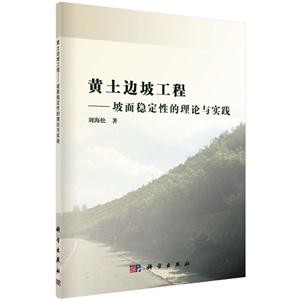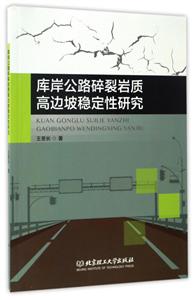
作者:张靖宇等
页数:218
出版社:科学出版社
出版日期:2017
ISBN:9787030495419
电子书格式:pdf/epub/txt
内容简介
NULL
本书特色
Yang Changwei、Zhang Jingyu、Lian Jing、 Yu Wenying、Zhang Jianjing编最的《Slope Earthquake Stability(精)》This book begins with the dynamic characteristics of the covering layer-bedrock type slope, containing monitoring data of the seismic array, shaking table tests, numerical analysis and theoretical derivation. Then it focuses on the landslide mechanism and assessment method. It also proposes a model that assessing the hazard area based on the field investigations. Many questions, exercises and solutions are given. Researchers and engineers in the field of Geotechnical Engineering and Anti-seismic Engineering can benefit from it.
目录
1 Introduction1.1 Background and Significance1.2 Review1.2.1 Shaking Table Test Technology1.2.2 Dynamic Characteristics of Slope1.2.3 Deformation Characteristics and Instability Mechanism1.2.4 Seismic Stability Evaluation Method1.2.5 Prediction Model for Earthquake-Induced Landslide Hazard1.3 Problems1.4 Research Objectives and Content
2 Seismic Array Monitoring Results Analysis2.1 General Condition2.2 Monitoring Data of Seismic Array in 5.1 2 Wenchuan Earthquake2.3 Response Characteristics Analysis2.4 Frequency Spectrum Response Characteristics2.4.1 Fourier Spectrum Along Elevation2.4.2 Seismic Ground Motion Response Spectrum Along Elevation2.5 Brief Summary
3 Shaking Table Test of Rock Slopes3.1 Large-Scale Shaking Table Test Design3.1.1 Purpose3.1.2 Installation3.1.3 Similarity System3.1.4 Similar Materials3.1.5 Test Instruments and Monitoring Points Disposition Principle3.1.6 Testing Points Disposition3.1.7 Design and Manufacture3.1.8 Sensors3.1.9 Loading Scheme3.1.1 0 Data Collecting System3.1.1 1 Result Record3.2 Result Analysis3.2.1 Influence Factors of Acceleration Amplification Effect3.2.2 Fourier Spectrum and Response Spectrum of Acceleration3.3 Brief Summary
4 Numerical Analysis Research4.1 Brief Introduction to GDEM4.1.1 Advantages of GDEM Software4.1.2 Fundamental Principle of GDEM4.1.3 Verification4.1.4 Fundamental Function4.1.5 Modeling Progress and Methods4.2 Key Problems in Numerical Analysis4.2.1 Numerical Analysis Model4.2.2 Material Parameters and Constitutive Model4.2.3 Boundary Conditions4.2.4 Seismic Ground Motion Input Conditions4.3 Verification of Numerical Analysis Results4.4 Seismic Dynamic Response Features4.4.1 Acceleration Amplification Effects4.4.2 Acceleration Fourier Spectrum4.4.3 Acceleration Amplification Effects4.5 Local Topography Effect4.5.1 Key Problems in Numerical Analysis4.5.2 Calculation Results Analysis4.6 Brief Summary
5 Theoretical Solutions of Acceleration Amplification of Hill5.1 Formula Derivation5.1.1 General Thinking and Basic Assumption5.1.2 Generalized Analysis Model5.1.3 Derivation Process5.1.4 Time-Frequency Analysis Process5.1.5 Practical Application5.2 Solving Approach5.3 Verification5.3.1 Overview5.3.2 Verification5.4 Parameter Analysis5.4.1 Peak Value5.4.2 Frequency5.4.3 Bevel Angles5.4.4 “Whiplash Effect”.5.5 Comparative Analysis5.5.1 Brief Introduction of Some Seismic Design Code5.5.2 Code for Seismic Design of Buildings GB50011-20105.5.3 Specifications for Seismic Design of Hydraulic Structures DL/5073-20005.5.4 Design Specification for Slope of Hydropower and Water Conservancy Project SL/386-20075.5.5 Comparative Analysis5.6 Brief Summary
6 Slope Deformation Characteristics and Formation Mechanism6.1 Brief Introduction6.1.1 Numerical Simulation Method6.1.2 Numerical Analysis Model6.1.3 Numerical Constitutive Model and Material Parameters6.1.4 Boundary Conditions6.2 Deformation Characteristics and Disaster Mechanism6.2.1 Whole Landslide Process6.2.2 Landslide Hazard Phenomenon6.2.3 Landslide Mechanism Analysis6.3 Brief Summary
7 Slope Seismic Stability7.1 Slope Seismic Stability7.1.1 General Thinking and Basic Assumption7.1.2 Generalized Analysis Model7.1.3 Reflective and Transmission Coefficients7.1.4 Instant Seismic Stability Coefficient7.1.5 Time-Frequency Analysis Process of Seismic Waves..7.1.6 Practical Application of Seismic Wave Time-Frequency Effects7.2 Time-Frequency Analysis Formula Derivation7.3 Verification7.3.1 Overview7.3.2 Gravitational Stress Field7.3.3 Calculation Results’ Comparison7.4 Study on Parameters7.4.1 Incident Angle on Transmitted and Reflected Coefficients of the Structural Surface7.4.2 The Influence of Elasticity Modulus of Cover Layer on Transmitted and Reflected Coefficients of the Structural Surface7.4.3 The Influence of Incident Angle on Transmitted and Reflected Coefficients of the Structural Surface7.4.4 The Influence of Elasticity Modulus of Cover Layer on Transmitted and Reflected Coefficients of the Structural Surface7.4.5 The Influence of Elasticity Modulus of Cover Layer on Total Transmitted and Reflected Energy Coefficients of the Structural Surface7.5 Advantage7.6 Brief Summary
8 Prediction Model8.1 Field Investigation8.2 Controlling Factors8.3 Analysis of Controlling Factors8.3.1 Correlation Between Landslide Volume V and Horizontal Sliding Distance L and Vertical Sliding Distance H8.3.2 Correlation Between Bevel Angle tanθ and Equivalent Friction Coefficient f8.3.3 Seismic Ground Motion Attenuation Model Based on Measured Data of Wenchuan Earthquake 8.3.4 Correlation Between PGA and Horizontal Sliding Distance8.4 Prediction Model O8.5 Case Analysis of Donghekou Landslide and Magongwoqian Landslide8.6 Parameters8.7 Brief Summary
Conclusions and Prospects
Bibliography















